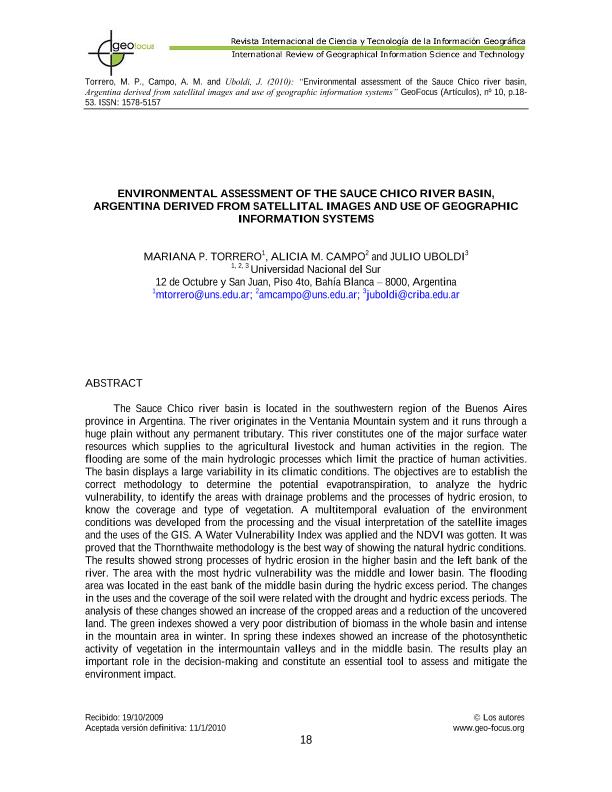Mostrar el registro sencillo del ítem
dc.contributor.author
Torrero, Mariana Paula

dc.contributor.author
Campo, Alicia María

dc.contributor.author
Uboldi, Julio

dc.date.available
2018-09-21T20:22:02Z
dc.date.issued
2010-03
dc.identifier.citation
Torrero, Mariana Paula; Campo, Alicia María; Uboldi, Julio; Environmental assessment of the Sauce Chico river basin, Argentina derived from satellital images and use of geographic information systems; Asociación de Geógrafos Españoles; Geofocus; 10; 3-2010; 18-53
dc.identifier.issn
1578-5157
dc.identifier.uri
http://hdl.handle.net/11336/60665
dc.description.abstract
The Sauce Chico river basin is located in the southwestern region of the Buenos Aires province in Argentina. The river originates in the Ventania Mountain system and it runs through a huge plain without any permanent tributary. This river constitutes one of the major surface water resources which supplies to the agricultural livestock and human activities in the region. The flooding are some of the main hydrologic processes which limit the practice of human activities. The basin displays a large variability in its climatic conditions. The objectives are to establish the correct methodology to determine the potential evapotranspiration, to analyze the hydric vulnerability, to identify the areas with drainage problems and the processes of hydric erosion, to know the coverage and type of vegetation. A multitemporal evaluation of the environment conditions was developed from the processing and the visual interpretation of the satellite images and the uses of the GIS. A Water Vulnerability Index was applied and the NDVI was gotten. It was proved that the Thornthwaite methodology is the best way of showing the natural hydric conditions. The results showed strong processes of hydric erosion in the higher basin and the left bank of the river. The area with the most hydric vulnerability was the middle and lower basin. The flooding area was located in the east bank of the middle basin during the hydric excess period. The changes in the uses and the coverage of the soil were related with the drought and hydric excess periods. The analysis of these changes showed an increase of the cropped areas and a reduction of the uncovered land. The green indexes showed a very poor distribution of biomass in the whole basin and intense in the mountain area in winter. In spring these indexes showed an increase of the photosynthetic activity of vegetation in the intermountain valleys and in the middle basin. The results play an important role in the decision-making and constitute an essential tool to assess and mitigate the environment impact.
dc.description.abstract
La cuenca del río Sauce Chico se localiza en el Suroeste de la provincia de Buenos Aires, Argentina. El río nace en las sierras del sistema de Ventania y discurre en una extensa llanura sin recibir ningún tributario permanente. Es uno de los principales recursos hídricos superficiales para el abastecimiento agrícola-ganadero y humano de la zona. Los anegamientos son uno de los procesos hidrológicos limitantes para las actividades humanas. El área se caracteriza por la variabilidad climatológica. Los objetivos son determinar la metodología adecuada para el cálculo de la evapotranspiración potencial, analizar la vulnerabilidad hídrica, identificar áreas con problemas de drenaje y procesos de erosión hídrica, conocer el grado de cobertura y tipo de vegetación existente. La evaluación multitemporal de las condiciones ambientales se realizó a partir del procesamiento e interpretación visual de las imágenes satelitales y el uso de SIG. Se aplicó un Índice de Vulnerabilidad Hídrica y se construyó el NDVI. Se comprobó que la metodología de Thornthwaite es la que mejor refleja las condiciones hídricas naturales. Los resultados mostraron intensos procesos de erosión hídrica en la cuenca alta y margen izquierda del río. El área de mayor vulnerabilidad hídrica correspondió a la cuenca media y baja. La zona anegada se localizó al Este en la cuenca media durante el período de exceso hídrico. Los cambios en los usos y cobertura del suelo estuvieron en relación con las épocas de sequía y exceso hídrico. Se observó un incremento de las áreas cultivadas y una reducción del suelo descubierto. Los índices verdes mostraron una distribución muy pobre en biomasa en toda la cuenca e intenso en el área serrana en invierno. En primavera se observó un aumento de la actividad fotosintética de la vegetación en los valles intermontanos y en la cuenca media. Los resultados contribuyen a la toma de decisiones y son una herramienta para mitigar los impactos sobre el ambiente.
dc.format
application/pdf
dc.language.iso
eng
dc.publisher
Asociación de Geógrafos Españoles
dc.rights
info:eu-repo/semantics/openAccess
dc.rights.uri
https://creativecommons.org/licenses/by-nc-nd/2.5/ar/
dc.subject
Cuenca del Río Sauce Chico
dc.subject
Vulnerabilidad Hídrica
dc.subject
Erosión Hídrica
dc.subject
Procesamiento Digital de Imágenes
dc.subject
Uso del Suelo
dc.subject
Ndvi
dc.subject.classification
Meteorología y Ciencias Atmosféricas

dc.subject.classification
Ciencias de la Tierra y relacionadas con el Medio Ambiente

dc.subject.classification
CIENCIAS NATURALES Y EXACTAS

dc.title
Environmental assessment of the Sauce Chico river basin, Argentina derived from satellital images and use of geographic information systems
dc.title
Argentina, a partir de imágenes satelitales y uso de sistemas de evaluación medioambiental de la cuenca del río Sauce Chico, información geográfica
dc.type
info:eu-repo/semantics/article
dc.type
info:ar-repo/semantics/artículo
dc.type
info:eu-repo/semantics/publishedVersion
dc.date.updated
2018-09-18T15:01:41Z
dc.journal.number
10
dc.journal.pagination
18-53
dc.journal.pais
España

dc.journal.ciudad
Barcelona
dc.description.fil
Fil: Torrero, Mariana Paula. Universidad Nacional del Sur. Departamento de Geografía y Turismo; Argentina
dc.description.fil
Fil: Campo, Alicia María. Universidad Nacional del Sur. Departamento de Geografía y Turismo; Argentina. Consejo Nacional de Investigaciones Científicas y Técnicas. Centro Científico Tecnológico Conicet - Bahía Blanca; Argentina
dc.description.fil
Fil: Uboldi, Julio. Universidad Nacional del Sur. Departamento de Geografía y Turismo; Argentina
dc.journal.title
Geofocus
dc.relation.alternativeid
info:eu-repo/semantics/altIdentifier/url/http://www.geofocus.org/index.php/geofocus/article/view/208
dc.relation.alternativeid
info:eu-repo/semantics/altIdentifier/url/https://dialnet.unirioja.es/servlet/articulo?codigo=3174778
Archivos asociados
